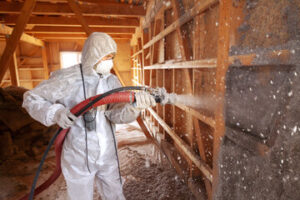Foundation Repair is an intricate process that requires the help of a professional. A few signs to look for include wall cracks, uneven floors, sticking doors and windows, and other problems caused by shifted soil.

Most contractors use either steel piers or concrete pilings. They dig holes around the home and hydraulically press them in, stacking them one on top of another until they reach the desired depth. Contact Foundation Plano Repair for professional help.
A crack in a foundation can cause homeowners to react in one of two ways: some panic that their house is no longer stable and seek immediate professional help, while others shrug it off as normal settling. It is important to understand that not all foundation cracks are created equal and that, when not addressed promptly, some can lead to serious structural damage.
The most common type of foundation crack is a vertical crack that results from the weight of your home causing the soil to shift. This is not an indication of a serious problem and, in most cases, can be easily repaired by a contractor with concrete patching materials.
Hairline cracks that run along the length of a foundation wall are also quite normal and can be filled with epoxy, polyurethane, or silicone caulk to keep water and insects out. However, these cracks can allow hydrostatic pressure to build in the foundation walls, which is a serious issue that requires professional evaluation and repair.
When foundation cracks appear in a horizontal or stair-step pattern, it is usually a sign of uneven settlement and could indicate that your foundation may be under significant stress and need to be repaired immediately. Likewise, any crack wider than a quarter inch and especially one that is accompanied by bulging or bowing of the foundation wall should be evaluated by a professional as soon as possible to prevent further structural damage.
Diagonal cracks running 30 to 75 degrees from the vertical are another common type of foundation crack that should not be ignored and are often a sign of serious structural issues. Depending on the size of the crack and whether it is in the foundation itself or in a basement wall, these cracks require different types of repair solutions but should always be addressed by a professional. Some methods used to fix diagonal cracks include carbon fiber straps that are bonded with epoxy to the foundation wall, or a hydraulic cement crack injection technique. A waterproof masonry sealant should be applied after the cracks have been fixed to protect your home from moisture infiltration.
Structural Damage
Structural damage happens when key parts of your home like the foundation, walls and supporting beams start to weaken or deteriorate. This can range from cosmetic issues like wall cracks to serious risks such as sinking or a collapsed home. Spotting and repairing structural damage early will help you keep your family safe.
If you notice that your doors or windows aren’t closing properly or water is seeping through the cracks in your walls, it’s important to contact a professional for foundation repair right away. These are signs that the foundation is shifting and can lead to serious damage if left unattended.
One of the main purposes of foundation repair is to restore your home to its original position. Your house was built to sit in a certain way and works best for you when it does so. Bringing your house back to this position also helps with other systems that are connected to the foundation, such as plumbing.
There are several ways to fix structural damage caused by foundation problems, including underpinning the foundation, repairing cracks and reinforcing the supporting beams. Foundation repair contractors can recommend the best solution for your situation after performing a thorough inspection of your home and foundation.
If your home has sunk due to soil compaction, removal of underground water or natural ground movement, it’s likely time for foundation repair. A professional will create a plan that pinpoints where support is needed, which usually includes the corners and perimeter of your home. In about 10% of cases, supports may also be needed under the center of your home.
To lift your home, a contractor will use concrete blocks and a jack to insert piling sections under your foundation. Then, they will use steel shims to raise the foundation and your home. Some contractors offer a final step called mud-pumping to fill the void created under your home during the lifting process.
Injecting a high-viscosity polyurethane polymer into the cracks in your foundation is the most effective method for repair. This flexible material can expand up to 20 times its volume, making it a strong and durable solution. It’s also less invasive than traditional exterior methods, with most repairs completed in just a few hours.
Water Damage
Most homeowners are aware of the potential damage to their foundations from water. However, fewer are aware of the many other signs and symptoms that could be related to foundation problems. Whether it’s doors or windows that jam, floors that are uneven or walls that bow, these changes affect the functionality of your home and should not be ignored.
Moisture is not only a threat to your foundation, but it can also cause mold and mildew. The spores of these organisms thrive in damp environments, and they can quickly spread throughout your home. This not only makes your home unsightly, but it can also be a health risk for those with asthma or other respiratory conditions.
Excessive moisture can also cause foundation shifts, especially in areas with expansive soils. These soils expand when they are wet and shrink when they dry, placing an unnatural amount of pressure on your foundation. This can lead to settlement and sinking of the foundation, which can then cause cracks throughout your house.
The best way to prevent excessive moisture is to have a professional landscaper plan and implement the proper grading of your property. This will ensure that the soil beneath your foundation slopes down and away from your home. In addition, you should avoid planting shrubs and trees too close to your foundation, as these plants can saturate the soil with water and create hydrostatic pressure.
After your foundation is repaired, you may notice some small cracks as the house adjusts to its new position. These are normal and can usually be filled with caulk or putty. However, if you notice a musty smell that lingers even after a thorough cleaning, this is a sign of severe dampness and should be addressed by a mold specialist or drainage contractor.
When the moisture and resulting cracks are resolved, your foundation should return to its original position and function as it was originally designed. This is why it’s important to hire a trusted and experienced foundation repair contractor for all your needs. With proper care, your foundation can last for the life of your home and beyond.
Timely Repair
A cracked foundation can be a serious problem that requires timely repair to prevent additional structural damage and protect the safety of your home. The longer you wait to get it repaired, the worse the crack will become and the more costly the repairs will be. There are several warning signs to look out for that will indicate it is time to call in the professionals. These include vertical cracks that appear wider at the top or bottom of the wall, horizontal or diagonal cracks, and doors or windows that no longer open or close easily.
Hairline cracks that are less than 1/8 inch wide are common and typically caused by drying shrinkage as the concrete cures. These can be filled with caulk designed for concrete to provide a temporary solution. If the cracks are in areas prone to movement, a polyurethane sealant is a more durable option.
Foundation cracks are often the result of hydrostatic pressure pushing against the structure. This is a force that is more than just the weight of your home-it’s also the tension that develops between soil and concrete when water moves through the soil faster than it can be absorbed by the ground. This causes the soil to push against the foundation, which in turn pushes against the basement walls and floors, resulting in cracks.
To stop this process, you need to relieve the pressure. This can be accomplished with helical piers. These are steel rods that go into the ground under the foundation like giant screws. They are much more effective than a folded-up napkin wedged underneath the foundation, which is what many homeowners attempt.
When you do decide to repair the cracks, it’s important to use a professional who uses the right materials and techniques for long-lasting results. Many methods of repairing cracks such as using caulk are only effective for 6 months to a year and will eventually be broken down by efflorescence, allowing water to seep through again.


